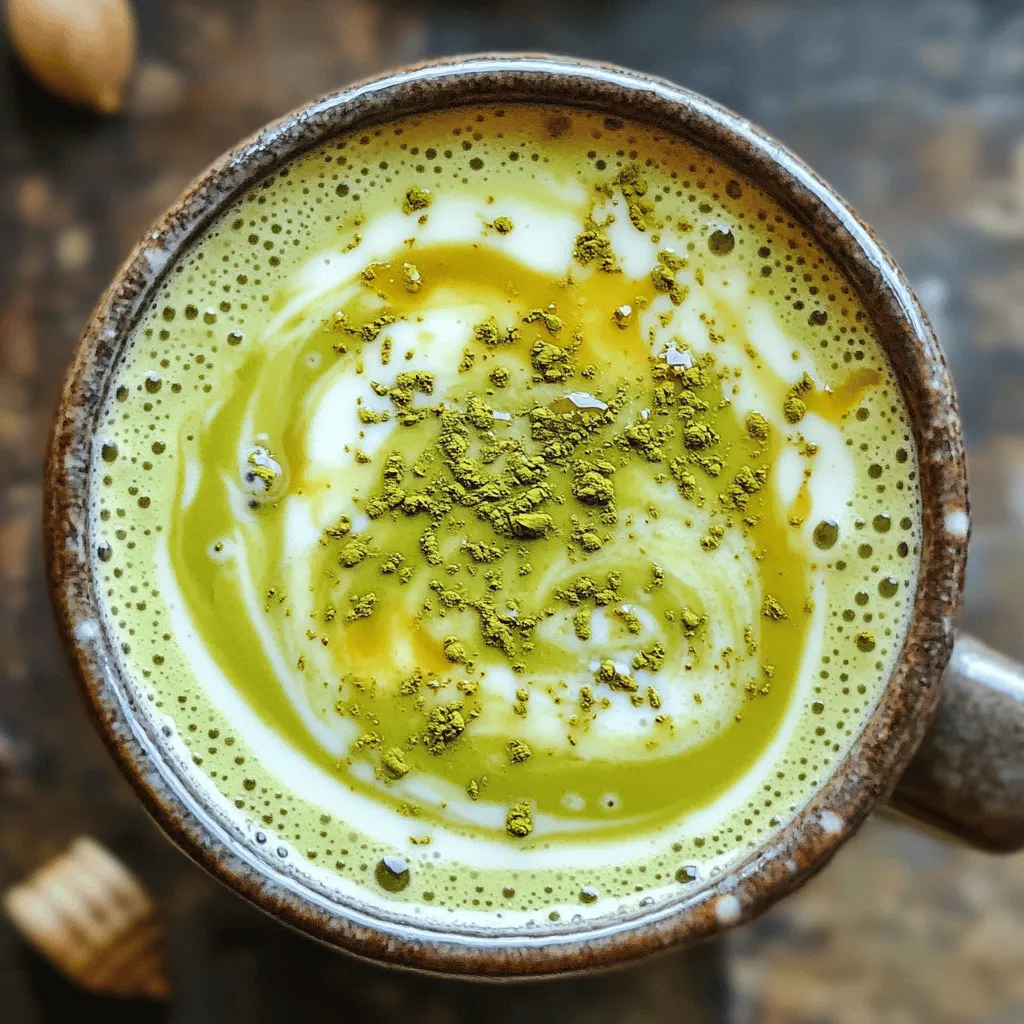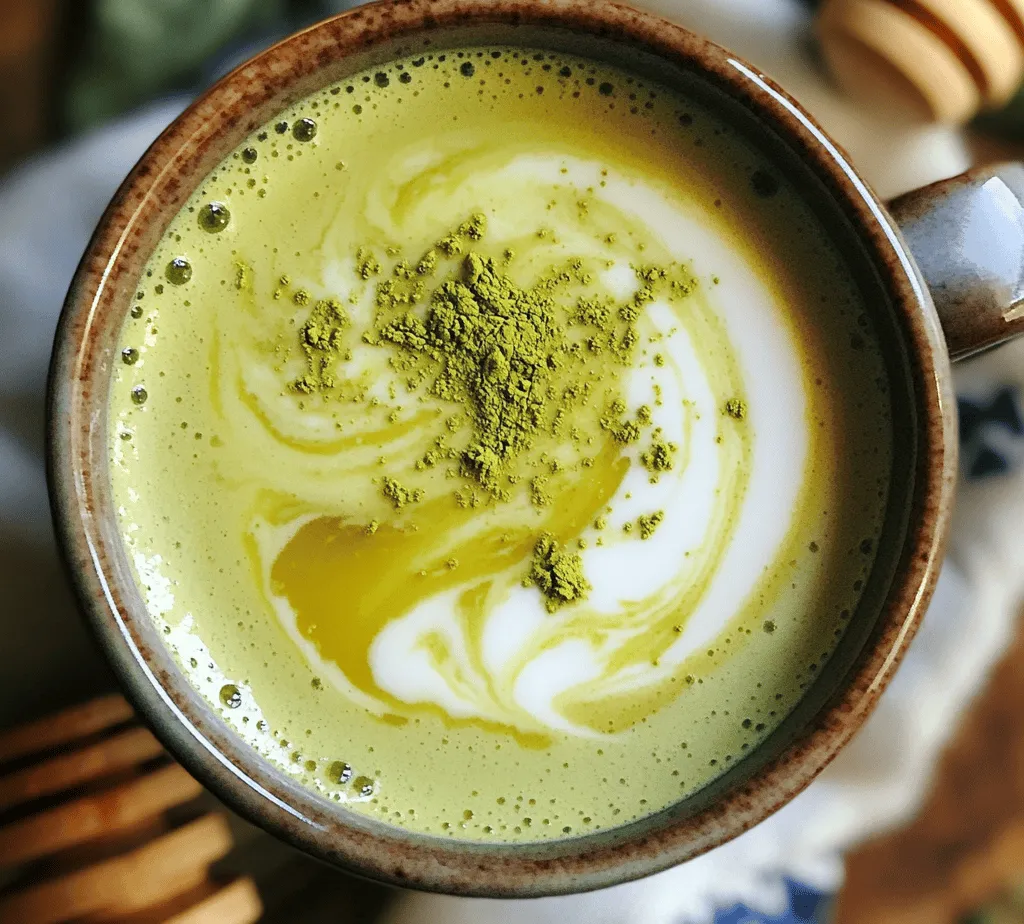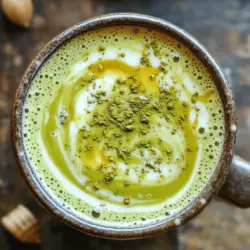Introduction
In recent years, matcha green tea has taken the culinary world by storm, capturing the hearts of health enthusiasts and tea lovers alike. This vibrant green powder, made from finely ground shade-grown tea leaves, has become a staple in contemporary diets, thanks to its unique flavor profile and impressive health benefits. From lattes to desserts, the versatility of matcha is unmatched, making it a favorite ingredient in cafes and kitchens around the globe.

Matcha is not just a delicious drink; it is packed with a wealth of health benefits. Renowned for its high antioxidant content, matcha is an excellent source of catechins, which are known for their cancer-fighting properties. Additionally, matcha provides a gentle energy boost without the jitters often associated with coffee. This is largely due to its unique combination of caffeine and L-theanine, an amino acid that promotes relaxation and focus. Whether you are looking to enhance your morning routine or simply enjoy a comforting beverage, matcha offers a calming yet invigorating experience.
Today, we will explore a recipe for Authentic Matcha Green Tea Bliss, which highlights the simplicity and quality of ingredients that make this drink truly special. The steps involved are straightforward, allowing you to enjoy a perfect cup of matcha in no time, whether you are a seasoned matcha drinker or new to the experience.
Understanding Matcha Green Tea
Before diving into the recipe, it’s essential to understand what matcha is and how it differs from regular green tea. Matcha is a finely powdered form of green tea made from the young leaves of the Camellia sinensis plant. Unlike traditional green tea, where the leaves are steeped and then discarded, matcha involves consuming the whole leaf in powdered form. This means you receive the full spectrum of nutrients and benefits that the tea leaves have to offer.
Historically, matcha has deep roots in Japanese culture, where it has been used for centuries in traditional tea ceremonies. These ceremonies emphasize mindfulness and the beauty of the moment, often accompanied by the preparation and enjoyment of matcha. The ritual of making and drinking matcha is not just about the beverage itself; it’s a holistic experience that engages the senses and fosters a sense of tranquility.
The process of harvesting and grinding matcha is meticulous and requires great skill. The best matcha is made from leaves that are shade-grown for several weeks before harvest, which enhances their chlorophyll content and gives the powder its vibrant green color. After harvesting, the leaves are steamed to prevent oxidation, dried, and then ground into a fine powder. When selecting matcha, it’s crucial to choose high-quality powder, as the flavor and health benefits vary significantly between different grades. Ceremonial grade matcha is the highest quality, ideal for drinking, while culinary grade is better suited for baking and cooking.
Ingredients Breakdown
To prepare a delightful cup of Authentic Matcha Green Tea Bliss, you will need only a few high-quality ingredients. Let’s break down each component and understand their roles in creating this exquisite beverage:
High-Quality Matcha Green Tea Powder
The cornerstone of this recipe is, of course, matcha green tea powder. Sourcing high-quality matcha is essential for both flavor and health benefits. Look for matcha that is bright green in color, as this indicates the presence of chlorophyll and high-quality leaves. Ceremonial grade matcha is recommended for this recipe, as it offers a smooth, rich flavor that elevates the overall experience. When purchasing matcha, consider brands that provide information about their sourcing and processing methods to ensure you are getting the best quality.
Hot Water
The temperature of the water used in preparing matcha is critical to achieving the perfect cup. Ideally, you want to use water that is between 160°F and 175°F (70°C to 80°C). Water that is too hot can scorch the matcha, resulting in a bitter taste and diminished health benefits. To achieve the right temperature, you can either bring water to a boil and let it cool for a few minutes or use a thermometer to gauge the temperature accurately.
Almond Milk (or Milk of Choice)
For those looking to create a creamy and delicious matcha latte, adding almond milk or your preferred milk alternative can enhance the drink’s texture and flavor. Almond milk is a popular choice due to its nutty flavor and lower calorie content compared to dairy milk. However, feel free to use any milk of your choice, whether it be oat, soy, or traditional dairy milk. Each type of milk brings its own unique flavor and nutritional profile to the drink.
Sweeteners
When it comes to sweetening your matcha, you have several options. Honey and maple syrup are two popular natural sweeteners that pair well with matcha. Honey offers a distinct floral flavor, while maple syrup provides a rich, earthy sweetness. Both options come with their own health benefits, as they contain antioxidants and other nutrients. When choosing a sweetener, consider your taste preferences and dietary needs to find the best match for your Authentic Matcha Green Tea Bliss.
Optional Ingredients
To elevate your matcha experience further, consider adding optional ingredients such as:
- Sea Salt: A pinch of sea salt can enhance the flavors and provide a delightful contrast to the sweetness.
- Vanilla Extract: This can add depth and complexity to the drink, making it even more enjoyable.
- Ice Cubes: If you’re in the mood for a refreshing iced matcha option, adding ice cubes can transform your drink into a cool treat.
Step-by-Step Instructions
Now that you have a solid understanding of the ingredients involved in making Authentic Matcha Green Tea Bliss, it’s time to dive into the preparation process. Follow these detailed steps to ensure you achieve the perfect cup of matcha every time:
Step 1: Sifting the Matcha
Start by measuring out the desired amount of matcha powder, typically around 1 to 2 teaspoons for one serving. To achieve a smooth texture and eliminate any lumps, it is essential to sift the matcha powder into your bowl. Use a fine mesh sieve for this process, as it allows the powder to aerate and results in a velvety consistency. Sifting is a crucial step to ensure that your matcha is evenly mixed with water and avoids any clumps during the whisking process.
Step 2: Adding Water
Once you have sifted the matcha, it’s time to add the hot water. Pour approximately 2 ounces (about 60 milliliters) of hot water into the bowl with the sifted matcha. Remember to use water that is around 160°F to 175°F to preserve the matcha’s delicate flavor and nutrients.
Step 3: Whisking the Matcha
Using a bamboo whisk (known as a chasen) or a milk frother, begin whisking the matcha and water together. Start slowly, allowing the powder to dissolve, and gradually increase your whisking speed. The goal is to create a frothy, smooth mixture with no lumps remaining. Whisk in a zig-zag motion or a circular motion until you see a layer of froth on the surface. This step is key to achieving the ideal texture and flavor profile for your matcha.
Step 4: Adding Milk and Sweetener
If you prefer a creamy matcha latte, pour in your choice of almond milk or milk alternative, adjusting the quantity to your taste. If desired, you can heat the milk before adding it to your matcha for a warm drink. Next, sweeten your matcha blend with honey or maple syrup, stirring gently to incorporate the sweetener evenly. Taste your matcha latte and adjust the sweetness according to your preference.
Step 5: Optional Enhancements
At this stage, you can enhance your matcha bliss with optional ingredients. A pinch of sea salt can elevate the flavors, while a splash of vanilla extract adds an enticing aroma. If you are making an iced version of the drink, this is the time to add ice cubes and mix thoroughly to create a refreshing iced matcha latte.
By following these steps, you will have crafted a delightful cup of Authentic Matcha Green Tea Bliss that not only satisfies your taste buds but also nourishes your body with its many health benefits. Enjoy your matcha experience, and stay tuned for more tips and variations as we continue to explore the wonderful world of matcha!

Whisking Techniques for Achieving the Perfect Froth and Consistency
To create the ultimate matcha green tea bliss, whisking is a crucial step that can significantly influence the texture and flavor of your drink. The traditional tool for this task is a chasen, a bamboo whisk specifically designed for matcha. When using a chasen, it’s essential to use a specific technique: hold the whisk at a slight angle and whisk in a zigzag motion, ensuring that you incorporate air into the matcha. This method not only helps to break up clumps but also creates a delightful froth that gives your drink a beautiful finish.
For those who may not have a chasen, modern alternatives like electric frothers or handheld whisks can also do the job. While these tools can save time, they may not give you the same level of control over the frothing process. If using an electric frother, whisk the matcha for about 30 seconds, ensuring to reach the sides of your bowl to fully incorporate the powder.
Heating the Milk: Tips for Avoiding Scalding and Ensuring Creamy Texture
The next step in crafting your matcha green tea bliss involves heating the milk. Whether you prefer traditional dairy or plant-based alternatives, heating the milk to the right temperature is key to achieving a creamy texture. Aim for a temperature of around 150°F (65°C). To avoid scalding, which can alter the milk’s flavor and spoil the overall taste of your matcha, remove the milk from the heat just before it starts to boil.
If you’re using a stovetop method, keep a close eye on the milk as it heats and stir consistently. For those who prefer using a microwave, heat the milk in short 30-second bursts, stirring in between to distribute the heat evenly. This careful heating technique will ensure a smooth and creamy result that beautifully complements the earthy notes of matcha.
Combining Ingredients: How to Balance Flavors Effectively
Once your matcha is whisked to perfection and your milk is heated, it’s time to combine the ingredients. Start by pouring the milk over the whisked matcha. To achieve the best balance of flavors, consider the ratio between matcha and milk. A common starting point is one teaspoon of matcha powder per cup of milk. However, feel free to adjust the amount of matcha to suit your taste preferences.
For a creamier drink, you might opt for a higher milk-to-matcha ratio, while a more intense matcha flavor can be achieved by using less milk. Use a spoon to gently stir the mixture to ensure everything is well combined. This step is crucial as it helps to meld the flavors together, creating a harmonious drink that is both refreshing and invigorating.
Sweetening and Serving: Personalization of the Drink to Cater to Taste Preferences
Sweetening your matcha green tea bliss is entirely optional and can be tailored to your liking. Traditionalists often enjoy their matcha unsweetened, but if you prefer a hint of sweetness, consider natural sweeteners like honey, agave syrup, or maple syrup. Start with a small amount and gradually increase to taste, ensuring that the sweetness does not overpower the matcha’s delicate flavor.
For those looking for sugar alternatives, options like stevia or coconut sugar can provide a lower-calorie option without sacrificing flavor. Once sweetened, pour your matcha green tea bliss into a favorite mug or bowl, and consider garnishing with a sprinkle of matcha powder or a dash of cinnamon for an extra touch.
Variations and Customizations
Exploring different milk options can significantly change your matcha experience. While cow’s milk provides a rich, creamy texture, plant-based alternatives like oat milk and coconut milk offer unique flavors that can enhance your drink. Oat milk’s natural sweetness and creamy consistency pair beautifully with matcha, while coconut milk imparts a tropical note that complements the tea’s earthiness. Experimenting with these options can lead to delightful discoveries.
You can also adjust the sweetness of your matcha by trying various sweeteners. Agave syrup is a popular choice for those seeking a vegan-friendly option, while coconut sugar offers a caramel-like flavor. For those on a low-sugar diet, consider using stevia or monk fruit sweetener to achieve the desired sweetness without the calories.
To elevate your matcha further, consider adding spices like cinnamon or nutmeg. These spices not only add warmth and depth but also bring additional health benefits. Superfoods like collagen or protein powder can also be incorporated for an extra nutritional boost, making your matcha not only delicious but also beneficial.
Iced Matcha: A Detailed Guide on How to Prepare and Serve Iced Matcha Green Tea Bliss
For a refreshing twist, iced matcha green tea bliss is a fantastic option, especially during warmer months. Start by whisking your matcha powder with a small amount of hot water to dissolve it completely, as this prevents clumping. Once mixed, let the matcha cool to room temperature or place it in the refrigerator for a few minutes.
In the meantime, fill a glass with ice cubes and pour in your choice of milk. You can use the same milk options discussed earlier—cow’s milk, oat milk, or coconut milk. Pour the cooled matcha over the ice and milk, then stir gently to combine. Sweeten to taste using your preferred sweetener, and enjoy a chilled, invigorating drink that’s perfect for any occasion.
Health Benefits of Matcha Green Tea
Matcha green tea is not only a delicious beverage but also a powerhouse of health benefits. Its antioxidant properties are among the most notable advantages, as matcha contains a high concentration of catechins, particularly epigallocatechin gallate (EGCG). These antioxidants can help combat free radicals in the body, contributing to overall wellness and reducing the risk of chronic diseases.
Moreover, matcha can enhance mental clarity and focus, thanks to its unique amino acid profile, particularly L-theanine. This compound promotes a state of calm alertness, helping to reduce stress while improving concentration. As a result, many matcha enthusiasts use it as a natural alternative to coffee for sustained energy without the jitters.
Additionally, matcha may assist in boosting metabolism, making it a popular choice among those looking to manage their weight. The combination of caffeine and catechins in matcha has been shown to enhance fat oxidation and improve exercise performance.
The nutritional profile of matcha is impressive, laden with vitamins, minerals, and amino acids. A typical serving of matcha provides a good amount of vitamin C, selenium, chromium, and zinc, all of which play important roles in maintaining health and supporting the immune system.
Cultural Context and Enjoyment
Matcha holds a significant place in Japanese tea culture, where it has been consumed for centuries. Traditionally used in tea ceremonies, matcha embodies a sense of mindfulness and appreciation for the present moment. This cultural context enhances the enjoyment of matcha, encouraging individuals to slow down and savor each sip.
In modern coffee shops, matcha has gained popularity as a versatile ingredient, appearing in everything from lattes to smoothies. To fully appreciate matcha, consider pairing it with light snacks, such as rice crackers, mochi, or fresh fruit. These combinations can create a delightful tasting experience that complements the flavors of matcha.
Creating a matcha ritual can also elevate your enjoyment. Set aside a time each day to prepare and savor your matcha, perhaps incorporating calming elements such as soft music or a quiet space. This mindfulness can transform your matcha experience into a moment of relaxation and reflection.
Conclusion
In summary, making authentic matcha green tea bliss at home is a rewarding experience that combines simplicity with sophistication. By mastering the art of whisking, heating milk, and balancing flavors, you can create a drink that is both delicious and nourishing. The ability to customize your matcha with different milk options, sweeteners, and flavor enhancements allows you to tailor the experience to your personal preferences.
Encouragement to experiment with this recipe will help you discover the nuances of matcha and find the perfect combination that resonates with your taste buds. Remember, the quality of your ingredients plays a crucial role in the final outcome. By selecting high-quality matcha and mindful preparation, you can ensure a delightful matcha experience. So gather your ingredients, embrace the process, and indulge in the bliss of authentic matcha green tea.







Leave a Reply